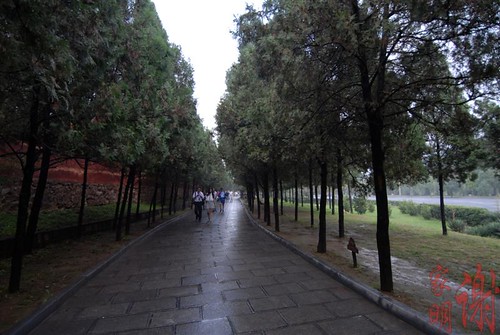
This is the " BIG WILD GOOSE " pagoda. Everyone asking the same question, do you think its a goose? why this pagoda doesn't look any like a goose? Why they name it goose?
hahaha ... dont ask me ... i also don't know. This is a holy place for Buddhists. It's some sort like a temple and some part are cemetery burial for holy monk.
In this area , what interest me are the structure and monument build by some ancient monks.
This area is damn big. Bigger than a Queensbay Shopping Mall.





The wall engraving are fascinating. I bet in this days , most of the modern architect can't do what the ancient does.

Story behind the curtain :
As the symbol of the old-line Xian , Big Wild Goose Pagoda is a well-preserved ancient building and a holy place for Buddhists.
The pagoda is located in the southern part of present day Xi'an, in what used to be Chang'an City in the Tang Dynasty. Actually, the formal name of the pagoda is Ci'en Temple Pagoda, but since the temple disappeared a long time ago, the pagoda is known by its other name.
The square, multistorey, brick structure is sixty-four meters high. On a high mound, it seems to rise into the sky.
Big Wild Goose Pagoda was first built in 652 in the Tang Dynasty. Xuanzang, a prominent Buddhist scholar of the time, planned to have a huge stone pagoda built to house the Sanskrit Buddhist scriptures he had brought back from India, but the plan fell through because it was difficult to find the needed stone and the cost was prohibitive. He decided instead to build a mud pagoda reinforced with bricks, but the mud pagoda was not strong and the construction was not done properly. The pagoda collapsed not long after it was built. It was rebuilt between 701 and 704 on the order of Empress Wu Ze Tian.
The pagoda tapers sharply from the first storey up, giving the entire structure the shape of a pyramid and making it stand very firm. Wooden steps and flooring inside allow people to go to the top and enjoy the splendid views in the suburbs of Xi'an. In the past, those who had passed the imperial examinations to become officials went there to inscribe their names on the pagoda, the ambition of every young official. As a result, gathered in front of the pagoda were tablets inscribed by those who had passed the imperial examinations in Shaanxi for more than a thousand years, from the Tang to the Qing Dynasty.
The outer walls of the present pagoda were covered by a thick layer of bricks in the Ming Dynasty. A tablet on the lintel of the door on the first storey is vividly carved with designs of a wooden hall in the Tang Dynasty. Kept under the pagoda is a stone tablet with an inscription made by Chu Suiliang, a calligrapher in the Tang Dynasty, which is an important relic.







































